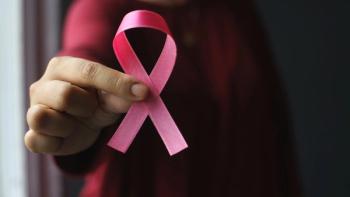
- Breast Cancer Special Issue 2017
- Volume 1
- Issue 1
Exploring Genetic Differences in Men's Breast Cancer
The genetic differences that distinguish men’s breast cancers may lead to new diagnosis and treatment options.
The incidence of male breast cancer is rising, and while it is still a rare and poorly understood disease, recent genetic studies have revealed fundamental differences from female breast cancer that could help guide treatment strategies toward a more tailored approach. That’s according to Patrick I. Borgen, M.D., chairman of the Department of Surgery at Maimonides Medical Center, who discussed the findings at the 2017 Miami Breast Cancer Conference, for which he serves as program chair.
UNDERSTANDING A RARE OCCURRENCE
Male breast cancer comprises less than 1 percent of all cancers in men and less than 1 percent of all breast cancers, according to a 2016 Histopathology review that Borgen discussed. For every 100 to 200 female patients with breast cancer, one man is diagnosed.
Male breast cancer tends to present in older patients and is often estrogen receptor (ER)-positive disease. In general, men lack knowledge about male breast cancer, and may ignore or be uncomfortable seeking care for breast complaints that are more commonly associated with women. This leads to more late diagnoses of advanced cancer in men.
The differences in screening and delayed diagnoses contribute to a 25 percent higher mortality rate in men than in women, although with standard treatment, survival rates are similar.
IDENTIFYING THE DIFFERENCES
Proportionally, significantly more male cases arise that are associated with hereditary gene mutations, and they display “vastly different” characteristics compared with inherited breast cancers in women, according to the Histopathology review. Mutations in the BRCA2 gene represent the strongest risk factor for male breast cancer, with a relative risk of 80 times that of the general population. Among BRCA2 mutation carriers, male breast cancers appear to be more aggressive. Meanwhile, while BRCA1 gene mutations are associated with basal-like cancer in women with breast cancer, they are not in men.
Different non-inherited gene changes have also been reported in men, although studies have been limited to just over 200 male breast cancer patients, and findings are mixed.
Changes in the PIK3CA gene are the most common mutations in male patients, occurring more frequently than in females, and in different parts of the gene. Unlike in women with breast cancer, recent studies have not detected KRAS mutations in men, and the TP53 mutation — the most common genetic change in females — was seen in only about 1 percent of male breast cancers.
Chromosomal-based changes are seen more often in male breast cancer, with some major studies showing more genetic regions that have erroneously gained material, and fewer that have lost material. Gene methylation, the most common mechanism by which tumor suppressor genes are silenced by a cancer, is seen less frequently in men.
USING GENETICS IN PROGNOSIS AND TREATMENT
Researchers have identified several genetic subtypes that could aid in figuring out a man’s prognosis. These include tumors that display more complex chromosomal rearrangement and high levels of methylation. In addition to the typical estrogen-responsive category, it is thought that there is a much less common type of male breast cancer that is resistant to hormonal therapy. That subtype is associated with mutations that cause epithelial mesenchymal transition, a process that transforms the epithelial cells that line various internal body surfaces into invasive cancer cells that are difficult to kill.
It may be possible to capitalize on these changes as a way of monitoring disease, by watching their activity along cell signaling pathways; that may be accomplished through imaging with PET scans, which can visualize a substance injected into the body as it collects in cancer cells. Moreover, these genetic glitches may turn out to be treatable with novel therapeutics that target cancer metabolism, the Histopathology article notes.
Another clue has emerged that may help determine which medications will work against male breast cancer: The genes associated with cell motility are different in male breast cancer than in female breast cancer. This, scientists believe, suggests that chemotherapies in the vinca alkaloid and taxane families, or newly developed drugs, such as epothilones or eribulin, may work.
EXPANDING OUR KNOWLEDGE
Since large clinical trials are impractical given the rarity of male breast cancer, Borgen suggested establishing national tumor repositories and prospective registries for men with breast cancer, which would open the door to both prospective and retrospective studies.
Articles in this issue
about 8 years ago
Keeping a Cool Headabout 8 years ago
Don't Get Sidelined by Chemotherapy's Side Effectsabout 8 years ago
Reconstruction Decisions: "Living Flat" After Breast Cancerabout 8 years ago
A La Carte Options to Treat Breast Cancerabout 8 years ago
The Logistics of Multigene Panel Testing in Breast Cancerabout 8 years ago
Piling on Drugs to Treat HER2-Positive Breast Cancerabout 8 years ago
As Genetic Testing for Cancer Expands, Questions Still Remain



